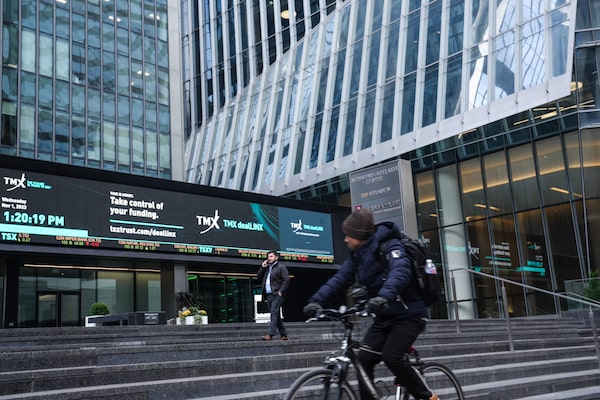
People walk past the TMX in Toronto, on Nov. 1, 2023.Chris Young/The Canadian Press
The Canadian stock market has an economy problem.
Over the past year, the TSX has deeply underperformed U.S. stock benchmarks, closely tracking the widening gap between the two countries’ economic growth readings. On both fronts, Canada is growing at about one-third the U.S. pace.
That’s no coincidence. The same failings sapping the Canadian economy of its vigour are also to blame for the run of shoddy performance in domestic stocks.
At the heart of Canada’s economic and stock-market mediocrity is a lack of private-sector investment.
For years, Canadian businesses have been loath to invest in things such as machinery and equipment, or productivity-enhancing research and development. Spending on those items has even started to decline in recent years.
“These are fundamentally important factors for equities,” Robert Kavcic, senior economist at BMO, wrote in a note to clients. “They drive earnings growth while also absorbing inflation, and they are right now tilted well in the U.S. direction.”
Canada’s growth problem is quickly becoming a matter of national urgency. Economists and business leaders speak of serious risks to Canadian prosperity from falling standards of living and declining competitiveness.
Real GDP per capita today has dropped back to 2014 levels. Some interpret this as a lost decade for Canadian living standards. And labour productivity has declined for three straight years – the worst run in at least four decades.
The only remedy is private investment, Stéfane Marion, chief economist and strategist at National Bank Financial, said in a recent report. “Private investment is the lifeblood of any economy.” It’s pretty important for the stock market, too.
A growing body of research suggests that R&D is especially crucial to stock returns. Which is a shame, because few in Canada appear to be doing very much of it.
A study released last July from Boston Consulting Group’s Centre for Canada’s Future ranked Canada second to last in R&D spending among 15 developed economies.
At about $700 per person, Canada’s R&D investment amounted to about one-third of U.S. levels.
The private-sector numbers are even worse, since about half of Canada’s contribution to R&D comes from governments and postsecondary institutions. Factor them out, and U.S. businesses are spending four times more on R&D than their Canadian counterparts.
Could this help explain why the U.S. stock market has left the TSX in its dust for more than a decade? A number of recent studies on the matter have come to a similar conclusion: Companies that invest more in R&D also tend to generate higher stock returns.
There are lots of technical reasons why this might be the case. One leading explanation is that the market misprices R&D intensive stocks based on how intangible assets are treated in financial statements.
Some studies also point to the role of intangible assets in the disappointing performance of value-investing strategies for several years now. And since the TSX is loaded with value stocks, it’s entirely possible that the Canadian market is being penalized for its limitations in R&D and innovation.
To be fair, the TSX has more problems than just R&D. It suffers for its relatively heavy weighting in sectors that are sensitive to higher interest rates, like utilities, real estate and telecoms. And it is light in the tech, communications and consumer discretionary sectors that have fuelled the biggest gains in U.S. stocks.
But it is becoming increasingly clear that the weaknesses in the Canadian stock market and the real economy are one and the same.
The resurgence in private investment needed to reverse the trends on either front, however, may continue to be elusive.
“It’s hard to revive business investment and productivity in Canada when foreign and domestic investors prefer to place their assets outside our borders,” Mr. Marion said.
Last year saw foreign investors sell a net $49-billion of Canadian stocks, while Canadian investors piled into international stocks. The combined net outflow amounted to 2.2 per cent of GDP – the worst result on record outside of a recession.